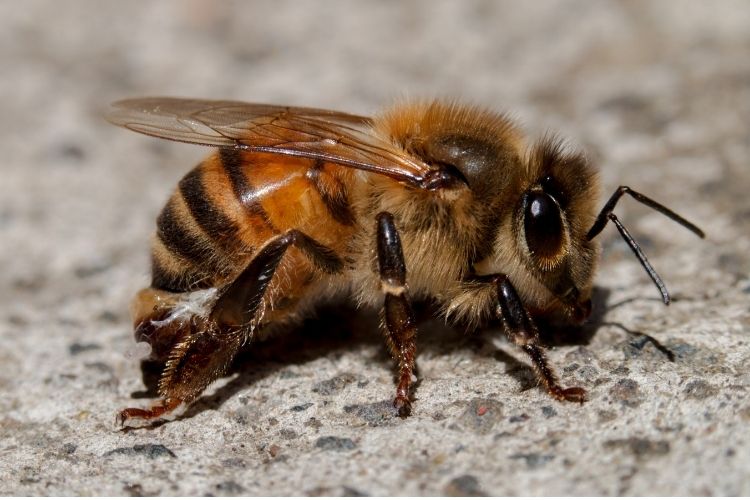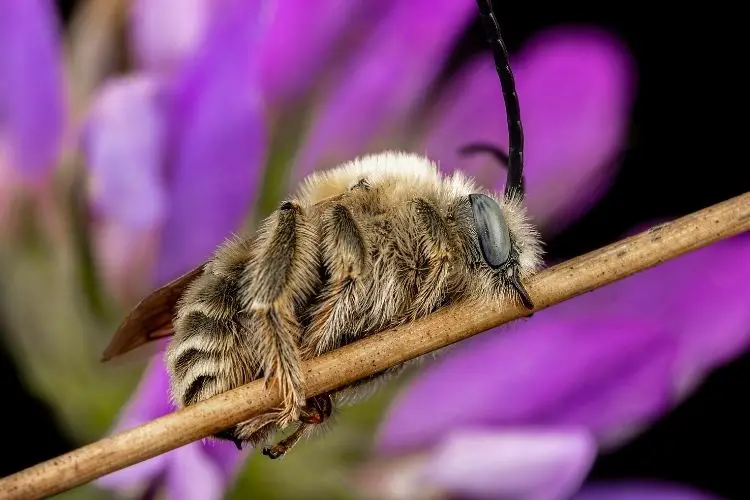Ever wondered what bees do at night… and whether they need sleep like humans and other mammals?
Honeybees do in fact sleep at night. While they don’t sleep in the exact same way as humans, they do have long rest periods where they remain inactive and recharge their energy levels.

What Is Sleep?
Given bees are very different from humans and other beings, we cannot assume they sleep exactly the way we do. So, how do we make sure they are sleeping instead of doing something else that looks similar to what we call sleep?
Well, there are three main characteristics of sleep:
- There is a period of inactivity usually linked to a specific posture or resting place and a reduction in movement.
- Reduced sensitivity to stimuli. In other words, a stimulus like light must be more intense to generate a reaction.
- Homeostatic regulation – this means, following sleep deprivation, there is compensation or a rebound effect.
To help us determine whether bees sleep, it’s also important to note the two mechanisms that regulate sleep:
- The circadian rhythm or circadian clock
- The homeostatic mechanism
The circadian rhythm works like an internal clock and tells us when the time is right to do certain things according to our environment.
Like us, forager bees are diurnal, which means they sleep at night and stay active during the day. This is because their main activities benefit from the sun’s light.
Then, there’s also the homeostatic mechanism. The tendency for our body to maintain the balance to make sure everything works as it’s supposed to.
You can probably feel this mechanism at work when you have been awake for a long time, and you start feeling sleepier as time goes on, and feel renewed after a good night’s sleep.
How Do Bees Sleep?
A highly influential study on bees’ sleep found strong relationships between their nighttime behavior and the three main characteristics of sleep (an extended period of inactivity, reduced sensitivity to stimuli and homeostatic regulation).
Using a one-frame observation hive, it was possible to see that some of the bees showed little to no movement of their heads, legs and thorax, and an increase of light brightness didn’t seem to generate any effect on them.
In contrast, the other group of bees were more active and concentrated around the brood area.
The Signs Of Sleep In Honeybees
In the second stage of the study, researchers isolated forager bees and observed their behavior under controlled conditions.
Even when isolated and unable to perform their regular daily tasks, they still showed a clear difference in how they behaved during the day compared with at night.
This controlled observation of forager honeybees also helped identify and confirm the initial indications of sleep seen with the help of the observation hive.
The signs of sleep behavior in honeybees are:
- Decrease in movement – At night, forager bees remain still in the same spot for several hours. They still showed intermittent movements of some parts of their body and grooming actions. However, compared to daytime, they moved significantly less. The reduction in movement was most evident when the antennae remained immobile, possibly indicating a solid relationship between antennal immobility and a deep sleep state.
- Decrease in thoracic temperature – During the rest period at night, bees maintained a reduction in the temperature in their thorax.
- Higher reaction threshold – the study showed a relationship between decreased sensitivity to stimuli with reduced movement of the antennae and a more noticeable downward inclination of their head. In other words, bees in the deepest sleep phase, as evidenced by their very still antennae, need a more intense stimulus to react.
- Decrease in muscle tone – When bees are falling asleep, their muscle tone or tension decreases gradually.
Additionally, forager bees that were sleep deprived for 12 hours increased the duration of antennal immobility the next day, signaling a rebound effect and thus, suggesting their sleep is homeostatically regulated.
What About Young Bees – Do They Sleep Too?
As mentioned earlier, there are differences in the way young and forager bees sleep. However, because young bees are known not to have a circadian rhythm, it wasn’t clear whether they slept or not.
A fascinating study by researchers of The Hebrew University of Jerusalem, Israel, found younger bees do sleep despite their around-the-clock tasks like taking care of the brood and queen.
During this study, it was also possible to identify three stages of sleep in both young and forager bees, with the first stage being the lightest and third stage the deepest.
Bees in the first stage were the most sensitive to light stimuli and moved their antennae more. Also, the bouts of sleep in this stage were the shortest.
In contrast, bees in the third stage showed a reduced muscle tone, the longest sleep bout duration, the lowest number of antennae movements, and the highest response threshold to light.
In addition, researchers identified brief arousals or awakenings in all three stages. This was true in both young bees and foragers.
The resting posture of the body and antennae and the response thresholds in young bees were like those in foragers that were in the same stage of sleep.
Both groups went from light to deep sleep gradually and passed from sleep to awake a similar number of times.
However, the main differences were shown in the duration of sleep bouts. On average, forager bees showed shorter and more sleep bouts than younger bees.
This group also usually went from light to deep sleep and from deep sleep to awake, passing through the different stages less often.
The younger bees passed between the three stages more frequently and had more prolonged bouts in the first sleep and shorter in the other two.
The Effects Of Sleep Deprivation In Bees
The effects of sleep deprivation in humans are well-known. We have likely experienced the impact ourselves. We might feel less friendly than usual, have difficulty communicating clearly, and not make the best decisions.
But what happens when bees don’t sleep?
For bees, the impact of sleep deprivation can become quite disrupting and even affect the whole colony – which is not surprising given how social they are.
Sleep deprivation impacts bees’ ability to communicate accurately where good food sources are to their hive mates, also affecting the foraging effectiveness in other bees.
Additionally, sleep seems to have a role in the consolidation of navigation memory. When forager bees were sleep-deprived after learning a new route to their hive, they would present a lower probability of getting home successfully from the same spot as the learning task on the next day.
Therefore, sleep deprivation seems to affect the consolidation of the new knowledge acquired in the navigation task.
At What Time Do Bees Go To Sleep?
The exact time bees go to sleep is difficult to determine, as it can vary according to their environment.
However, bees generally return to the hive just before the sun sets, as the sunlight has a vital role in their foraging activity by aiding navigation to and from the hive.
Once in their hive, forager bees go from active to inactive and initiate their resting period, shifting from a lighter sleep phase to a deeper one throughout the night.
Research has shown that bees tend to reach their deepest sleep late at night. In studies, bees showed a peak of antennae, head, and body immobility between 3 and 4 am, possibly indicating this is the time when they reach their deepest sleep.
Other studies used sound recordings to determine when the colony was less active as a whole. Researchers concluded that between 11 p.m. and 4 a.m. was the time at night when colony activity reached its lowest point during the summertime.
Interestingly, some studies seemed to show forager bees also take naps during the day, depending on the availability of food sources.
Where Do Bees Sleep?
European honeybees, or Apis mellifera, sleep inside the hive. However, where in the hive depends on their life stage.
Older bees usually sleep outside comb cells in the outer edges or perimeter of the hive, while younger bees tend to sleep inside the cells and closer to the center of the hive, where the brood is.
Do Bees Sleep In Flowers?
I’ve seen photos of bees sleeping scrunched up in flowers, and it made me wonder if my honeybees do the same.
After doing a bit of research, I found there are types of bees that sleep outside. Some even sleep by holding on to twigs with their mandibles – quite the unusual sleeping position.

These bees are called solitary bees, and the males usually sleep outside their nest, clamping onto tiny branches or inside flowers.
I did not find solid evidence that shows European honey bees sleep in flowers or outside, which makes sense to me as these bees probably wouldn’t tolerate low temperatures at night.
Summing Up…
Honeybees are diurnal, meaning they rest at night and become active during the day. The latter is true for forager bees with a strong circadian rhythm that times their activities to gain the most benefit.
While younger bees don’t have a circadian rhythm and tend to be active all day and night, there is evidence they sleep too.
Forager bees return to their hive when the sun sets and start their inactive period going through 3 different sleep stages, where the first one is the light sleep stage and the third is the deep sleep stage.
Researchers have found bees present signs of sleep, for example their body and head position and a lack of movement in the antennae. They also become less responsive to stimuli, their muscles become relaxed, and their thoracic temperature decreases.
Sleep deprivation in bees can affect their ability to communicate accurately through their waggle dance leading to less effective foraging. Additionally, it can inhibit navigation memory consolidation that might increase the chance of getting lost when returning to their hive.
